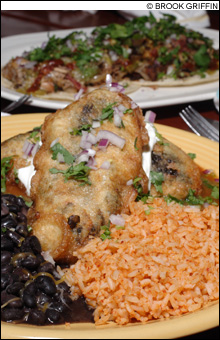 The first thing that struck me on both visits was that the background music was Brazilian. It shifts to salsa and some Mexican pop, but Brazilian seems weird.
The first thing that struck me on both visits was that the background music was Brazilian. It shifts to salsa and some Mexican pop, but Brazilian seems weird.
The chips are reasonably fresh and the salsa is entirely fresh and has cilantro. The old system for rating Mexican restaurants was whether or not there was fresh cilantro in the basic salsa. It was a binary rating system. Zócalo has plenty of fresh cilantro, although winter cilantro is only somewhat better than winter tomatoes and not as fine as winter basil.
Several dishes and drinks are very good, but others, especially among the regional specialties, are quite far from authentic, and therefore unsatisfactory. Because Zócalo’s location, the former Istanbul Café, is a very nice restaurant space, you can have a wonderful evening here by ordering carefully.
Your best bet on an appetizer is probably the “Guacamole en Molcajete” ($8.50), which is made fresh tableside on a cart and presented in its own black-lava mortar (ours was in the shape of a pig). Freshness trumps a lot with guacamole, and we inhaled every bit with the very good white-corn tortillas provided. The tamal ($4.95) might work with optional green sauce. We had it with mole, which was unusually light-colored and sweet, so you could actually taste the chocolate; it was as though it were milk chocolate instead of bitter chocolate. Scrape it off, and you have a fine banana-leaf tamale, Yucatecan-style, with a spicy filling of chicken (option: vegetables).
For something closer to a Tex-Mex taste, Tinga Poblana ($5.95) does the three-tostada arrangement with a topping of spicy shredded pork and cheese on the salad, salsa, and sauce. Pozole ($5) is here in the Guadalajaran style familiar from most of the Boston Mexican restaurants actually owned by Mexicans: a soupy stew of pork and large grains of hominy corn that is hotter and redder than the green-chili version of the American Southwest.
There is plenty for vegetarians, and the tostada de nopales ($5.95) makes reasonable use of pickled cactus-leaf shreds on three corn tostadas. The heaps of salad, cheese, sauce, and salsa make these too large for one or two bites, and so a little awkward and dangerous to eat by hand. Not for first or second dates, amigos. Ensalada al Carbon ($5.50) is a more-normally arranged salad topped with a few grilled vegetables: eggplant, squash, zucchini, and fine-sliced carrot. The lime vinaigrette is quite good.
Our favorite entrees on both visits were variations of fried stuffed poblano peppers ($14.95) from a special-menu insert. The key here is the lovely frying of these large, mild chilies, which have just a little bite, and the savory fillings of pork, mushrooms, cheese, and such. Almost all dinners come with a lot of yellow rice and black beans. The rice is a little dry — I always remember the words of my Puerto Rican friend Estella Carion when describing her year living in Mexico: “The Mexicans don’t know how to make rice at all” — but the beans are excellent.
You can get many of the same flavors quite satisfactorily in burritos, enchiladas, or quesadillas — all with vegetarian options as well. Our vegetarian guest did a create-your-own quesadilla ($6.95 one add-in/$8.25 for two), specifying pinto beans. With some fresh pico de gallo (rough-chopped salsa here) and guacamole, it was a delightful if predictable platter.
However, getting into more-authentic dishes was somewhat discouraging. Legumbres en pipian ($10.95) was a vegetable stew of the same mixture as the grilled-vegetable salad, but the pipian was a travesty of the real Oaxaca pumpkin-seed sauce: granular, too sour, unspiced, and barely edible. The prized dish of the Yucatán is Cochinita Pibil ($11.95): shredded braised pork in an incendiary mix of sour-orange and chili flavors, traditionally marinated, wrapped in leaves, and baked. The version at Zócalo wouldn’t pass even in Cancun — it’s just hot shredded pork, saved only by the rice and beans. Camarones al Mojo de Ajo ($13.95) sounds safe, and the portion is plentiful medium shrimp, but the tomato-chili sauce overwhelms the garlic.
Drinks are a better picture, with a number of bottled Mexican beers and canned fruit nectars. Sangria comes red, white, and even mango, and a half-liter of mango ($11) was fine for three of us. It was a typical sangria served with a cinnamon stick in each glass, and it had an unusual warm, mango flavor in the middle of the orange start and red-wine finish. Decaf coffee ($2) was excellent, apparently fresh brewed.
Given the attractive surroundings and excellent service, you’ll want to linger, but there are only two desserts. Vanilla flan ($4.95) was grainy and a little tough on both visits, but flan is always welcome. Olé bread pudding ($5.50) was a scoop of chocolate bread pudding, rather like fallen chocolate cake, with a choice of raspberry or mango sauces. Get the mango.